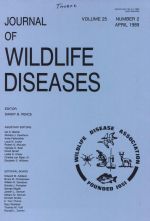Two collection methods for screening the mallard (Anas platyrhynchos) population in the Netherlands for the ingestion of spent lead shot were compared. One method consisted of examination of gizzards from mallards shot by hunters (n = 2,859) and the other method consisted of examination of gizzards from mallards caught in duck traps (n = 865). The 95% confidence interval of lead shot ingestion in the mallard population estimated by the first method was 1.7 to 2.9% and by the second method 1.1 to 3.1%. These values were not significantly different. From the numbers of lead pellets embedded in the gizzard wall in hunter-killed and trapped mallards it was estimated that at least 22 to 68% of the trapped ducks had been hit by lead shot previously, but survived. Furthermore, this study shows that it is reasonable to assume that a substantial part of the pellets which are identified (in this study and other studies) as ingested, may well have been shot into the gizzard lumen at some time before the birds were actually killed. To avoid lead poisoning in mallards and in raptors depredating waterfowl hit by lead shot, a change to steel shot is advocated.
How to translate text using browser tools
1 April 1989
A Comparison of Two Methods to Establish the Prevalence of Lead Shot Ingestion in Mallards (Anas platyrhynchos) from The Netherlands
J. T. Lumeij,
H. Scholten

Journal of Wildlife Diseases
Vol. 25 • No. 2
April 1989
Vol. 25 • No. 2
April 1989
“eendenkooi”
Anas platyrhynchos
hunting
lead poisoning
mallard
Netherlands
trapping




